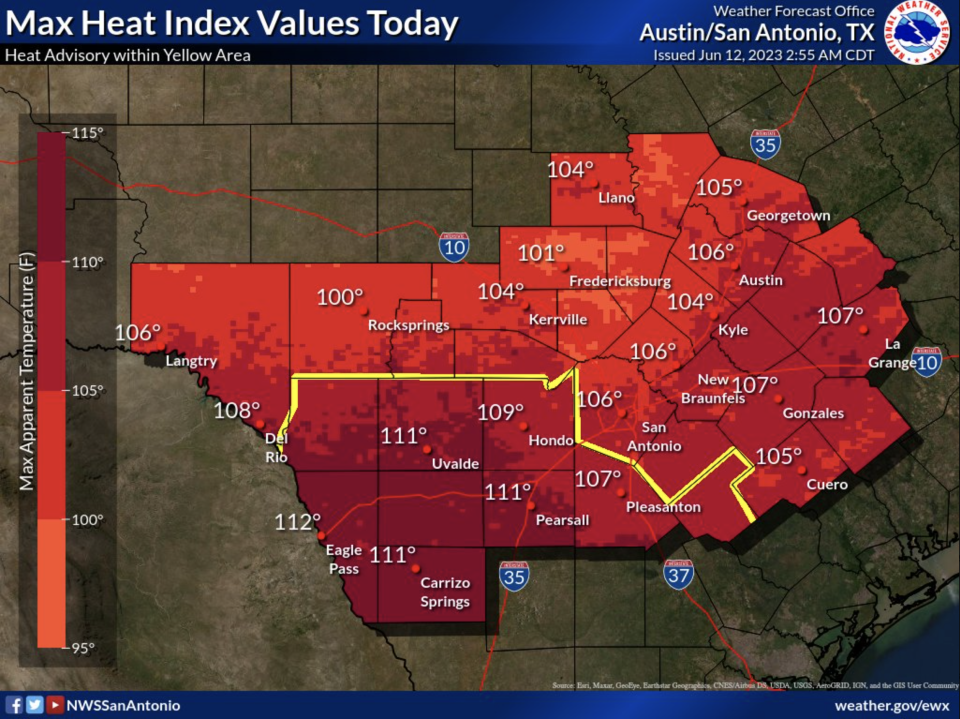Temperatures in Austin are quickly approaching 100. Here's what to know, how to stay safe
The Austin heat is starting to set in, and it's probably here to stay.
Temperatures are expected to rise above 100 degrees frequently throughout the week, according to the National Weather Service, with heat index values, known as "feels like" temperatures, reaching the mid- to upper 100s.
Monday's high will be 99, though it's likely to feel like 106, according to the weather service.
Tuesday is expected to be the first 100-degree day of the year in the area, and temperatures are forecast to remain in the 100s during the day through Sunday. Friday is expected to claim the week's highest temperature, with a forecast high of 105.

Temperatures are expected to drop to the mid-70s during the nighttime all week, the weather service reported. Meteorologists predict little rain, plenty of sun and wind gusts between 10 and 20 mph for the week.
1/2 Near record to record heat remains in the forecast throughout the week across south-central Texas, with the hottest days likely coming Thursday and Friday. It will be important to plan ahead to stay cool during these dangerously hot conditions. https://t.co/WAISH7mKBi pic.twitter.com/ARoGnPXuuT
— NWS Austin/San Antonio (@NWSSanAntonio) June 12, 2023
High temperatures bring high health risks
High temperatures can pose serious risks to the human body, medical experts warn. They encourage people to stay inside between 2 and 6 p.m., the hottest part of the day, if possible. They also suggest people wear breathable, light-colored clothing; stay hydrated with water; and wear sunscreen.
Advice from medical experts: Use hydration, common sense to protect yourself from Central Texas heat
If you're spending time outdoors this week, be mindful of symptoms of these potentially harmful heat illnesses:
Heat cramps: Noticeable sweating; muscle aches; prickly heat rash, especially in areas where clothing meets the skin such as the waistband; and dizziness. To cool someone down, move the person to a cooler area; hydrate; remove excess clothing; and put cold compresses (a wet towel or shirt or an ice pack) on hands, feet, armpits, neck or forehead. Call a doctor to get an assessment.
Heat exhaustion: Flushed skin, sweating even more heavily, cold or clammy skin, nausea, not wanting to eat, and a shallow heartbeat. Move the person to a cooler area, hydrate with water or an electrolyte drink, remove excess clothing, and use cold compresses or spray them with water to cool them down. Call a doctor to see if you need to go to the emergency room or a doctor's office.
Heat stroke: No sweating, fast heartbeat, confusion, fainting or feeling faint, breathing quickly, confusion or delirium, loss of consciousness, and a high temperature. This is a medical emergency. If you can quickly drive the person to an emergency room, great. If not, call an ambulance. While driving or waiting for the ambulance, try to do all the same interventions as for less serious heat illnesses: hydration, cooler area, less clothing and cold compresses.
Previous reporting from American-Statesman staff writer Nicole Villalpando contributed to this story.
This article originally appeared on Austin American-Statesman: Austin temperatures expected to top 100 degrees. How to avoid the heat

